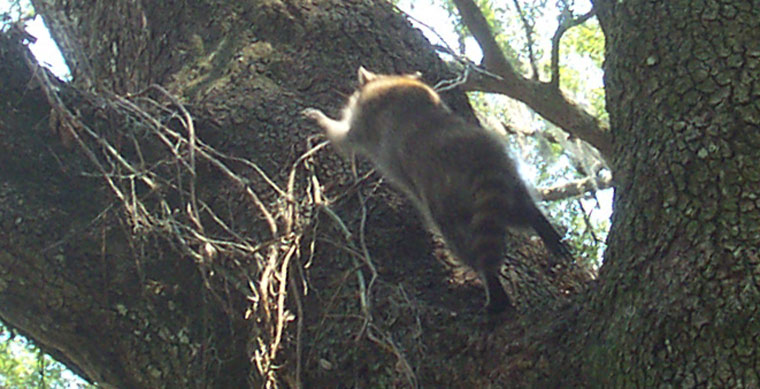-
info@aaanimalcontrol.com
Call us for help in your town
Humane Wildlife Education
Do raccoons prefer to live and sleep in trees?
Need raccoon removal in your hometown? We service over 500 USA locations! Click here to hire us in your town and check prices - updated for year 2020.
Raccoons spend a lot of their time in trees, and because of this they have become very keen climbers. Trees offer protection, particularly from predators on the ground, and the raccoon has a few of those. Foxes, coyotes, and even cats and dogs have all been known to attack these furry little creatures, and in the wild, it’s said that the average raccoon won’t make it past its third birthday. Just to give you some comparison, the oldest raccoon in captivity was about 13 years of age. Things such as predators, humans, cars, disease, trappers, starvation and hyperthermia are all common reasons why the raccoons rarely make it into full adulthood.

Living in the trees offers the raccoons an advantage. Many other animals are not quite as good in the climbing department, and that means they won’t be able to follow the raccoon as it scampers up there. Raccoons also like to nap in the trees, particularly when it gets really warm, after they have eaten. You will usually find these napping trees are idyllically placed close to water. This will be because of the plentiful bugs and other critters that the raccoon can eat, as well as the water in which they can swim and also drink.
If you have trees in your back garden, there’s a good chance they’ve already been eyed-up by a rogue raccoon, or perhaps even a sassy squirrel. Tree trunks lead to tree branches, and these tree branches could actually lead right onto the roof. It is second nature to the raccoon to get up high, so to them, your house is just another tree that they must get to the top of. Once it’s up there, your entire top half of the house is vulnerable from attack. The most hit areas on homes from raccoons tend be places such as attics, chimneys, crawl spaces, in sheds, garages and other outbuildings, under stairs and porches.
Although it is lovely to have trees on your land, you should make sure that they are not creating a drawbridge, of sorts, for wild invaders to walk right on in. How often do you check your attic? Would you know if there were areas of damage? When was the last time you performed any maintenance on your home? If you do not take care of the building, it will soon be a prime target for many wild animals, raccoons just being one of them, and perhaps one of the biggest. (And noisiest!)
The good news is that there are plenty of things you can do to stop trees from becoming a raccoon-aid in your garden or on your land. You should first make sure that you are trimming branches away that lead right to your home. Could a raccoon climb up a tree trunk, along a branch, across onto the top of your fence and then on to your roof? If it could, it’s time to cute the tree branches back.
If there are any patches of damage up on your roof, or holes that the animal could have used to gain access, you will need to repair them. Mesh hardware cloth can help protect your home form the ‘chewiest’ of creatures, including rats and mice, as well as raccoons, and you should opt for 1/4 inch stuff. You can also use metal flashing. Do not use plastic or wood. These are not a barrier for these animals, and they can easily chew and tear apart those materials.
For more information, you may want to click on one of these guides that I wrote:
How much does raccoon removal cost? - get the lowdown on prices.
How to get rid of raccoons - my main raccoon removal info guide.
Example raccoon trapping photographs - get do-it-yourself ideas.
Raccoon job blog - learn from great examples of raccoon jobs I've done.
raccoons in the attic


















